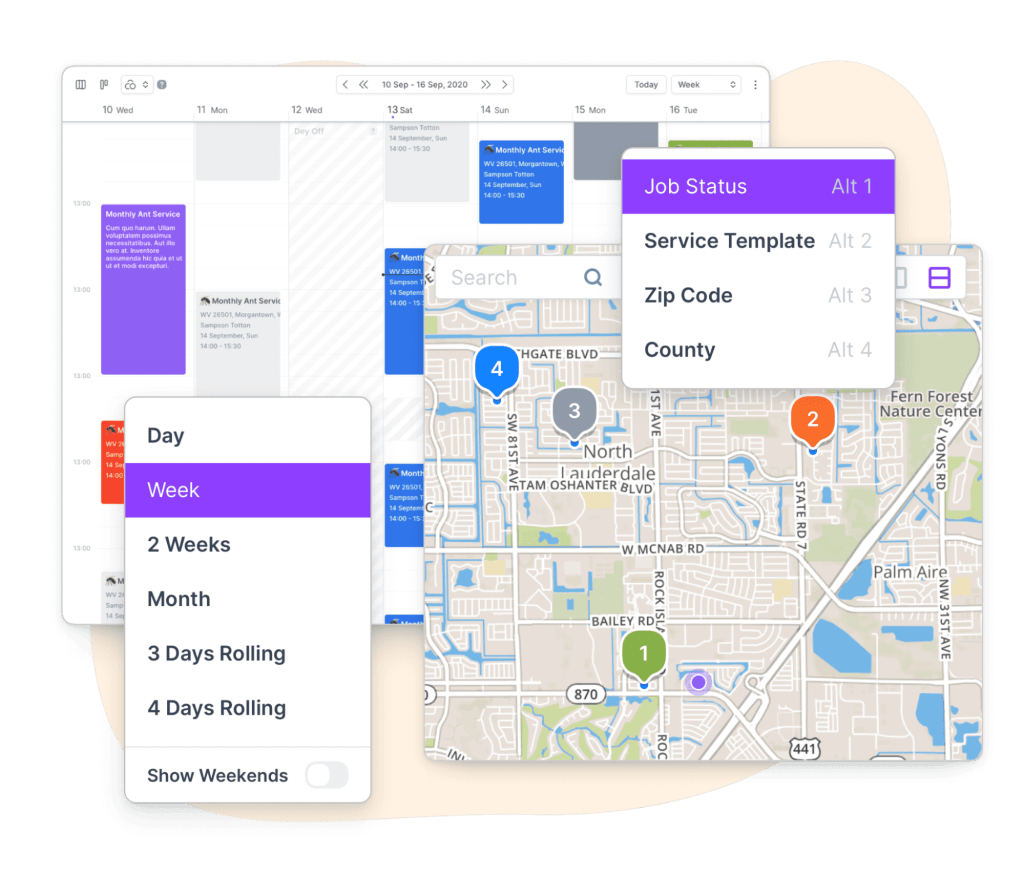A step-by-step guide to writing a pest control business plan
GorillaDesk Staff

Imagine you get a call from a homeowner who can’t get rid of their ant problem. Once on site, your technician discovers the hidden colony and gets to work solving the root of the problem.
This is the same game-changing discovery that a comprehensive pest control business plan can uncover for your company. By creating a business plan, you can identify any inefficiencies that are costing you money, then take action to treat the problem.
Removing these issues boosts your pest control business profit margin and sets the stage for healthy business growth. Get ready to conduct a deep inspection of your company and learn how to create a pest control business plan, plus how to make your business stand out to investors.
What is a pest control business plan?
Your pest control business plan is a comprehensive document that outlines your goals, strategies, and operational plans. It acts as a roadmap for starting your pest control business and expanding it in the future, and it can even help you secure funding if you need it.
Why do you need a business plan?
Along with acting as a guide for growing your company, a business plan is essential for finding investors and securing funding. Here’s why:
- It shows credibility: Potential lenders can refer to your business plan to see how well you’ve thought out your idea and developed a roadmap to becoming a successful pest control business.
- It shows profitability: Investors tend to avoid risk, and a business plan shows them that investing in your pest control company is anything but risky. Detailed financial projections, income statements, and balance sheets help convince investors that your business is stable and successful.
- It shows you’re prepared: Business plans also include your company’s weaknesses and how you’ll address them. This can boost lenders’ confidence in your success—and also gives you a solid starting point for managing those risks.
You can think of your business plan as a demonstration of your capability as an owner and the viability of your small business idea.
How to write a pest control business plan
Your pest control business plan should include these essential elements:
Executive summary
Your executive summary is a snapshot of your entire business plan. It should summarize your business mission, the services you offer, and your market analysis results. It should also engage your readers—especially since investors may use your summary to decide whether they should continue reading the rest of your business plan.
Your executive summary can also include:
- Market opportunity: A summary of your market research and competitor and customer analyses
- Products and services offered: A full list of your product and service offerings
- Marketing and sales strategies: A quick look at how you plan to engage and sell to customers
- Financial highlights: Your current and projected finances, such as projected net profit, initial startup costs, and break-even time frame for operating costs
You might find it easier to write the executive summary last since its contents depend on other sections of your business plan.
Company overview
Your company overview is your first chance to dive into the details of what makes your business unique. Include information about the types of pest control services you offer, such as commercial or residential pest control, and any specialties, like organic chemicals or fumigation.
Additionally, use this section to answer questions like:
- Why did you start your business?
- What’s your mission statement?
- What milestones, like the number of customers served, amount of revenue, or number of new hires, have you achieved to date?
- What is your business’s legal structure, such as an S-Corp, LLC, or sole proprietorship?
You can also give investors insight into your future goals for your business here. Before finalizing this section, sketch your value propositions (eco-friendly treatments, recurring service plans), customer segments (residential, commercial), channels and costs. A fast way to do this is with the business model canvas generator by Canva.
Industry analysis
You should already know a lot about your local pest control market. Gathering this knowledge helps you create a pest control marketing strategy, get familiar with your competitors and their strategies, and understand any trends affecting the pest control industry.
You’ll want to provide the following details in your industry analysis section:
- Target market: Describe your target market, its growth projections, and the total potential market size for your pest control business.
- Competitors: What pest control businesses also operate in the same target market?
- Suppliers: What companies are the primary suppliers for you and your competitors?
- Trends: Have you noticed any trends that have affected your industry? These could be changing customer preferences or new technology like AI.
This information improves your ability to make strategic business decisions and shows lenders you’re an industry expert.
Customer analysis
This section identifies the customers you currently serve and future new customers. If you provide multiple types of services, you can break this section down into customer segments like residential customers, government customers, and commercial customers.
Include customer profiles, or personas, in this section to cover demographic information like:
- Age ranges
- Locations
- Family or business size
- Marital status
- Homeownership
- Education
- Ethnicity
- Income levels or company budget
- Job titles and roles
- Lifestyle
- Interests and hobbies
- Values
You’ll also want to create psychographic profiles of your customers. These explain customers’ attitudes, beliefs, wants, needs, pain points, and potential objections.
Competitive analysis
Here, you’ll go over both indirect and direct competitors to your business.
Indirect competition can include DIY pest control tools like ant baits or rodent traps that customers can purchase at the store.
Direct competition includes other pest control businesses that offer the same or similar services in your target market.
You’ll need to provide additional details about your direct competitors here as well. Dig around to identify the following:
- What customers do they serve?
- What services do they provide?
- What pest control prices do they charge?
- What pricing strategies, like referral discounts or tiered plans, do they offer?
- What do they excel at?
- What are their weaknesses?
Finally, you’ll want to share your pest control business’ competitive advantage. Your “thing” could include services or treatment methods that competitors don’t offer, having a more experienced team of technicians, or offering high-quality customer service.
Marketing plan
Your marketing plan details your strategies for the following:
- Your unique value proposition (UVP)
- Your products and services
- Prices and pricing strategies
- Place, or the location of your business and how it affects your success
- Promotion, or how you’ll reach potential customers through different methods like ads, social media, or search engine optimization
When explaining your promotion strategies, don’t forget to include both online and offline approaches like pest control ads, billboards, and direct mail.
You should also note any strategies to improve customer retention. Long-term customers can boost your profitability and show potential investors there’s less risk in funding your pest control startup.
Operations plan
Your operations plan section walks investors through your daily business operations, such as:
- Scheduling
- Creating estimates
- Billing
- Customer service
- Inventory management
- Compliance
Additionally, your operations plan should feature a list of business goals, or milestones, you want to achieve along with the dates you hope to achieve them. Some ideas include:
- Reaching a certain amount of revenue
- Building a website
- Obtaining a business loan
- Purchasing new equipment or supplies
- Training staff
- Signing contracts with a certain number of customers
Think of these as long-term goals that indicate your business is headed in the right direction.
Management and team
Here, you’ll describe your management and team, their qualifications, and their roles. You can also note any pest control licenses certain technicians obtained or whether they have prior pest control experience.
If your team is small or lacks certain skills, you can build an advisory board to bring on external stakeholders to share their industry knowledge and help you grow your business.
Financial plan
The last section of your pest control business plan covers your financial plan for at least the next five years. It details your startup costs, revenue projections, and break-even analysis to show potential lenders the financial health of your business.
Important documents to share in your financial plan section include:
- Profit and loss statement: Also called an income statement or P&L, this document shows your revenue, expenses, and final profit.
- Cash flow statement: Your cash flow statement helps you understand how much money you need to run or grow your business. It’s a critical part of planning that ensures you never run out of money.
- Balance sheets: Your balance sheets should detail your assets, like current marketing campaigns to target new service areas, and liabilities, like loans you need to pay back.
Include financial statements for each month and quarter, your first year, and each year after that. You should also include information about any current funding sources, like your personal savings or existing loans and investors.
5 tips to help your pest control business stand out
From thoughtfully crafted strategies to efficiency-boosting tools, gain investor interest with these tips:
1. Develop a UVP
Your UVP tells investors why your business is different—and possibly better—than your competitors’. A strong UVP can attract investors looking to differentiate their portfolios.
Some potential starting points for your pest control business UVP include:
- Specialty services, like bed bug or termite treatments
- Eco-friendly pest control solutions
- Child- and pet-friendly treatments
You can also point to your team’s excellent customer service or comprehensive pest treatments as features that set your business apart.
2. Improve operational efficiency
Using GorillaDesk helps you manage time-consuming tasks like scheduling and dispatching. (Source)
Your operational efficiency directly impacts your bottom line. Using tools like GorillaDesk to optimize routes and technician schedules can reduce expenses and technician downtime while also shortening the amount of time it takes for payments to arrive by automating your invoices.
3. Promote your services
Let potential customers know you’re available to help them with pest problems by promoting your business both online and offline.
Offline promotional strategies include billboards, flyers, and postcards with your business information, services, and any special offers.
Online strategies include running ads on platforms like Google Ads, setting up and optimizing your pest control website, and posting on social media.
You should also claim any business listing profiles like Yelp to provide the most up-to-date information and address customer questions.
4. Create excellent customer experiences
GorillaDesk makes it easy to ask customers to leave a review on your online business listings. (Source)
Positive experiences drive customers to write a good review, with 38% of consumers in 2024 saying they write reviews when they have a good experience. And with 33% of U.S. consumers always checking local business reviews, this means providing review-inspiring experiences is essential for promoting your business.
But it’s not just customers who are watching. Investors also want to know if your business can grow through referrals and whether you can maintain a predictable cash flow thanks to higher customer loyalty.
Word-of-mouth marketing through sources like reviews can also strengthen your brand reputation—especially if you respond to customer reviews. Software like GorillaDesk makes it easy to capture customer thoughts and recommendations by automating your pest control review strategy. Once you complete a job, the software includes a note asking customers to leave you a review.
5. Provide essential training
Training your pest control technicians and office staff benefits them and your company in the following ways:
- Improved service quality
- Increased efficiency
- Improved compliance and risk mitigation
- More customer satisfaction and trust
- Increased upselling opportunities
Prioritizing training also shows investors that you’re committed to long-term growth.
Take your pest control business to the next level with GorillaDesk
Built with service businesses like yours in mind, GorillaDesk includes a handful of features designed to make your life easier.
Invite customers to use the portal to review estimates and select a service, leave reviews for your business, and request future treatments. When it’s time for your technicians to hit the road, GorillaDesk streamlines your scheduling and routing to speed up arrival times and save on gas. Finally, you can automate your billing and invoices so customers always have the latest cost information—and you can accept payments in the field.
All of these efficiencies quickly add up to make your business an attractive investment for lenders and investors. Find out why GorillaDesk is an essential tool for pest control business owners like you. Start your 14-day free trial now.
Other posts to check out
Make the move from paper to digital: A step-by-step guide for field service pros
If your field service business is still doing business on paper, it’s time to make a change. Here’s how to find success with a move to digital.
Pest control marketing: Let’s make that phone ring
With so many other local pest control companies making competition tight, keeping that phone ringing with new customers may not feel as easy as you thought. To keep your pest control business growing takes marketing know-how. Here are our best tips.
How to get more positive customer feedback
Customers trust online reviews just as much as word of mouth from friends and family. The truth is: Online reviews can make or break your local services business. Here’s how to build that glowing reputation your service deserves.
Tree service marketing: 11+ ideas to drive more customers in 2025
Drive more leads with our ultimate tree service marketing guide! Discover 11+ proven strategies to grow your business and attract the right customers.
How to start a tree service business in 2025
Learn how to start a tree service business with step-by-step guidance on planning, licensing, equipment, marketing, safety, and scaling your company.
Landscaping services list: What to offer your customers
Discover the top landscaping services to offer for maximum profit. From design to maintenance, expand your business with our comprehensive landscaping services list.
Transform your business
Try it free for 14 days. No credit card required. Instant setup.
★★★★★
We will be customers for life
“I can not say enough good things about GorillaDesk it saves us so much time and money. The customer service is the best. I would recommend GorillaDesk to anyone no matter what industry. I trained my employee in 5 minutes on how to use it. We will be customers for life.”

Ryan Sullivan
Business Owner
Ready to Get Started?
Get all our amazing features and top-rated support, with no credit card required.








